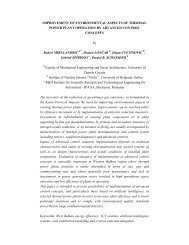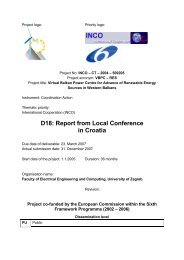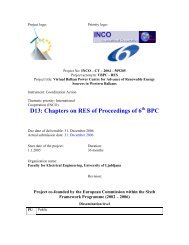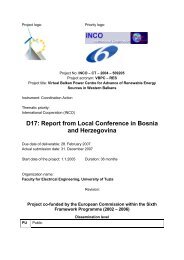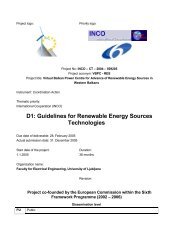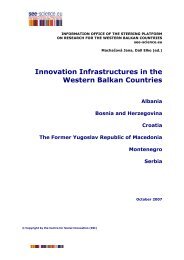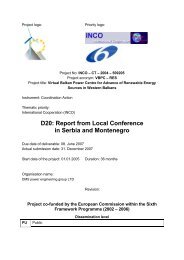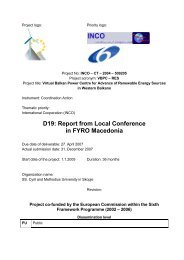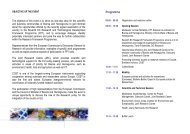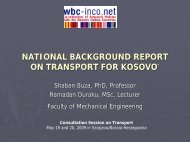National Profile
National Profile
National Profile
You also want an ePaper? Increase the reach of your titles
YUMPU automatically turns print PDFs into web optimized ePapers that Google loves.
The industrial sector in Italy is characterized by<br />
some weaknesses:<br />
It is mainly composed of small companies. About<br />
26 90% of companies have less than 20 employees and ty of companies are the inefficiency of the public ad-<br />
would easily suggest a massive use of photovoltaic, wind ces).<br />
27<br />
Italy<br />
“It is important for the Italian economy to improve<br />
and strengthen the manufacturing sector, due to<br />
the fact that a large number of companies have a<br />
rigid structure and management mentality.“<br />
ITALY<br />
FLExIBLE MANuFAcTuRINg<br />
the number of companies with more than 250 employees<br />
is half that of France and Germany. This<br />
"industrial dwarfism" limits companies’ capacity to<br />
invest in research and to produce new innovative<br />
and high-added-value products.<br />
The investments in research, both public and private,<br />
are not enough to sustain competiveness of<br />
the Italian economy. The total expenditure in R&D<br />
amounts to just 1% of the national GDP and only<br />
50% of this is made by enterprises.<br />
Most of the companies are excessively specialized<br />
in sectors with a relatively low rate of development<br />
(such as fashion, furniture, traditional mechanics<br />
etc.) and, even the biggest ones, have a rigid structure,<br />
rarely having a "lean" approach to manufacturing.<br />
The weight of the Italian manufacturing industry<br />
in the international markets is equal about to 4.5%.<br />
The first five production sectors, in order of market<br />
share, are the footwear industry (15%), furniture<br />
(14%), domestic appliances (14%), glass and ceramics<br />
(12%) and mechanical engineering (10%). By<br />
contrast, the weight of the products of the Information<br />
and Communication Technology, i.e. the pro-<br />
EuROPE gOINg gREEN<br />
Italy exceeds the limit of CO2 emissions established by<br />
the Kyoto protocol causing heavy penalties. It is estimated,<br />
in fact, that in the five-years period between 2008-2012,<br />
a debt between 1 and 2 billion dollars will be accumulated,<br />
that corresponds to a debt of 0.7 million Euros per day.<br />
This is mainly due to the following reasons:<br />
The dependence of Italy on non-renewable sources particularly<br />
on fossil fuels;<br />
The Italian freight transportation is mainly done by<br />
trucks, in a country where the railway network is not<br />
fully developed and the shipping (theoretically favou-<br />
ducts with a higher technological content, amounts<br />
to just 1%.<br />
Other factors that influence the competitive capaci-<br />
ministration bodies, the regulatory system, the lack<br />
of the infrastructure system and the credit market.<br />
Despite these weaknesses, the Italian production system<br />
presents some undeniable strength.<br />
Italy stands out for the organization of the industrial<br />
districts, for economic tradition, for branding policies,<br />
for very high inclination to entrepreneurship (there is<br />
a high rate of new entrepreneurial activities) , for the<br />
creativity of entrepreneurs and for the particular Italian<br />
style and design.<br />
In addition, a well developed automotive sector (FIAT<br />
group and others) with many allied industries presents<br />
a considerable strength and potential with high level<br />
of innovation and research.<br />
It is important for the Italian economy to improve and<br />
strengthen the manufacturing sector, due to the fact<br />
that a large number of companies have a rigid structure<br />
and management mentality.<br />
The goal is to cultivate a business culture that focuses<br />
on the importance of acquiring a new approach, where<br />
the keywords are innovation, research and a lean mentality.<br />
rable due to the peninsular geography of the territory),<br />
could have a higher potential, both cost- ecology - wise.<br />
In comparison 62% of freight in Italy is made by trucks<br />
(Germany 21,4% France 15,7% UK 11,8%) and only 10<br />
% by rail transport.<br />
Italian industries significantly contribute to the green<br />
house gases emission (mainly steelworks, refineries and<br />
cement plants). Selected industries that contributions<br />
in million tons of GHGs: thermoelectric -146,6, cement<br />
production - 31,4, refining - 26,0, steel production - 13,9,<br />
paper production - 5,0, glass production - 2,9.<br />
Significant CO2 emissions are related to the city traffic<br />
due to the deficiencies of the public transport and of the<br />
lack of a more sustainable mobility. Local public transport<br />
in Italy is used by only 15% of the population.<br />
Investing in new technologies and infrastructures that<br />
would allow a drastic reduction of emissions, is vital for<br />
Italy, not only to improve the life quality and limit the<br />
huge environmental damages, but also to face the heavy<br />
sanctions deriving from the non-compliance with the<br />
Kyoto protocol targets.<br />
The possibility of exploiting the renewable energetic sources<br />
(wind, photovoltaic and thermal solar), expending the<br />
railway network as well as technologically enhancing,<br />
gREEN ENERgY MARKET<br />
Italy has an emblematic situation. The country, where<br />
the geographical and meteorological conditions<br />
and hydroelectric energy, produces 77.5% of its energy<br />
by non-renewable sources and only 22.5% by renewable<br />
sources (mainly by hydroelectric power). It is to consider<br />
also that the energy produced covers about 80% of the<br />
national demand, while the remaining 20% is imported<br />
from abroad (Table 1).<br />
Such a relaiance on fossil fuels established Italy as the<br />
13th place in the world ranking of the most pollutant<br />
countries according to the World Resources Institute and<br />
International Energy Statistic. It is important to notice<br />
that Italy does not use nuclear energy that in some countries<br />
provides up to 30% of the energy.<br />
It is important to guarantee higher energy autonomy to<br />
A sector with high growth potential is the geothermal<br />
energy. It has been estimated that the production of geothermal<br />
energy could grow by a factor of 10 in the next<br />
40 years. The energy produced could supply 3.5% of the<br />
annual world production of electricity and the 3.9% of<br />
the heating. But this target may be achieved only thought<br />
research and development activities since new technologies<br />
are required to advance this energy sector.<br />
But the future, according to IEA (International Energy<br />
Agency), is in the exploitation of heat from hot rocks<br />
using the “enhanced geothermal system” (EGS).<br />
and finally the improvement of the quality and efficiency<br />
of public transport, are all issues that offer a opportunity<br />
of growth and improvement.<br />
The sectors of potential development mentioned above<br />
strictly depend on the new technologies development and<br />
on improvement of the existing ones.<br />
For example, innovative embedded systems would allow<br />
an efficient and sustainable management of the dial-abus<br />
service, or informative systems that permit the users<br />
to know, in real time, the position and the waiting times<br />
of the public service vehicle, exploiting GPS systems and<br />
smart phones.<br />
the country, decreasing the dependence from the foreign<br />
imports (at the moment that Italy has few fossil resour-<br />
The Italian potential for an improvement in the sector<br />
is related to solar energy that could guarantee a wider<br />
development of photovoltaic systems, as well as more<br />
efficient Concentrating Solar Power (CSP), mainly in the<br />
southern regions.<br />
However, it is important to note a progress made in the<br />
growth of solar and wind energy production in the last<br />
years. This growing trend of wind and photovoltaic is, in<br />
fact, encouraging, thanks to the <strong>National</strong> government<br />
policies and to the commitment of big public research<br />
centers (ENEA).<br />
Statistics:<br />
Table 1 Renewable energy sources, installed capacity in MW (source: ec.europa.eu)<br />
By 2050 more than half of the expected potential may derive<br />
from the use of deep hot rocks – available anywhere<br />
– through the use of EGS geothermal systems. To take<br />
advantage of this technology it is however necessary to<br />
accelerate the research activities, to ensure its commercial<br />
availability as early as 2030.<br />
Italy is in a unique position from a geological point of<br />
view, second only to Iceland. Italy possesses a virtually<br />
inexhaustible energy source that could guarantee the<br />
nation’s energy independence.<br />
Italy



